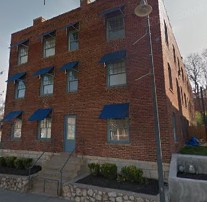Rochester Hotel
Introduction
Author-Uploaded Audio
Introduction to the Rochester Hotel by Michael Patton; recording created by Black Archives of Mid-America
Text-to-speech Audio
The Rochester was built by the George M. Bliss Construction Company in 1919-1930. Along with the Street Hotel, it was one of the only hotels where visiting African Americans could find accommodations during the 1930s and 1940s. Unlike the Street Hotel, the Rochester has survived the urban redevelopment projects that razed large swaths of the 18th & Vine district in the second hald of the twentieth century. Because it is adjacent to the Mutual Musicians Foundation, this is the place where jazz artists such as Count Basie, Jimmy Rushing, and many others would have stayed during visits to the city. The hotel also provided accommodations for visiting teams for the Negro League. Before becoming a hotel, the building was a 24-unit apartment complex serving a working-class clientele; today, the building has resumed this initial function, now containing 8 apartment units.
Images
The former Rochester Hotel of Kansas City

Backstory and Context
Text-to-speech Audio
As African American migrants left the south in the hopes of finding a better life in places like Kansas City, real estate and construction companies cashed in on the need for more housing in segregated cities. This was a lucrative business because of the high demand for housing and the fact that African American residents could only live in certain parts of the city, like the 18th & Vine district where the Rochester is located. The hotel was constructed between 1919 and 1920 by the George M. Bliss Construction Company; originally, the building contained 24 apartment units that were leased to working-class African Americans. Bliss was white and, in 1920, lived far away from the denser urban areas where he built these apartments. [1]
In 1940, the building became the Rochester Hotel and offered rooms on a daily, weekly, or monthly basis. During the first half of the twentieth century, there were a host of similar buildings in the area, as land prices were expensive and most African American residents of the district could only afford to rent rooms or apartments in larger residential complexes. While leading Black figures in the city exhorted renters to stop renting and start buying, very few African Americans could afford to do so. Indeed, most complexes like the Western Apartments/Rochester Hotel were owned by white people; in 1913, just before the apartments were built, only 3.4 percent of Black residents of Kansas City owned property. The pressing need for housing, the poverty of many African Americans, and the segregated urban landscape combined to create poor living conditions in many of the housing options accessible to lower- and working-class African Americans. [2]
Hotels like the Rochester were some of the few places that visiting African Americans—like the jazz musicians and baseball players for which the historic district is so well known—could stay, and the movement of artists and athletes through residential spaces influenced the surrounding area profoundly. Next door to the Rochester is the Mutual Musicians' Foundation building, which was originally purchased the Musicians Local Union 627 in 1928 to serve as the union headquarters. Local 627 benefited tremendously from the influx of visiting musicians, some of whom ended up sticking around Kansas City, especially during the Great Depression. [3] While the Rochester catered to a working class population, other hotels in the area like the now-razed Street Hotel were more luxurious and combined residential, dining, and entertainment options under one roof. The famous Blue Room, celebrated by a replica connected to the American Jazz Museum, was part of Street's Hotel.
Many of the large residential complexes like the Rochester and Street's were razed as part of urban renewal projects after World War II. The Rochester building is one of the largest surviving residential buildings from this period, though it no longer functions as a hotel. Once again, the building contains apartments, with recent property records indicating that there are 8 units in the building—significantly fewer than the 24 that existed during the days of the Western Apartments. [4]
Sources
- Department of Commerce—Bureau of the Census, "Fourteenth Census of the United States: 1920—Population," Kansas City, Jackson, MO, Ward 4, District 0073, page 9559.
- National Register of Historic Places Multiple Property Documentation Form - Historic Resources of the 18th and Vine Area of Kansas City, Missouri, 1991, Section E, pages 5-6.
- "Territorial Bands and a New Headquarters," Musicians Local 627. Accessed February 13th, 2020. https://library.umkc.edu/spec-col/local627/text/territorial/index.htm.
- "Property Report for 29-620-13-06-00-0-00-000," Jackson County, MO. https://jcgis.jacksongov.org/propertyreport/PropertyReport.aspx?pid=29-620-13-06-00-0-00-000
